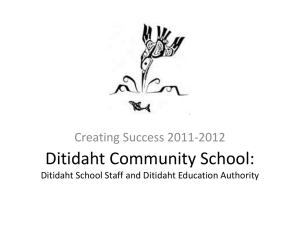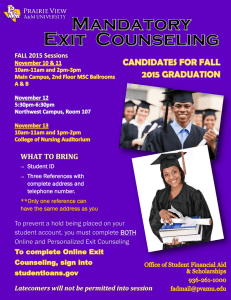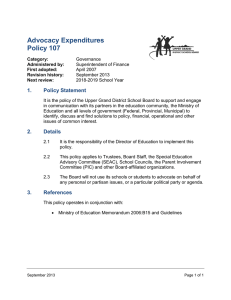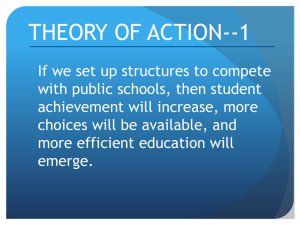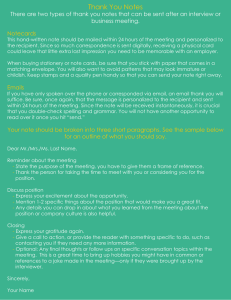the January 2015 update of the BC`s Education Plan +
advertisement
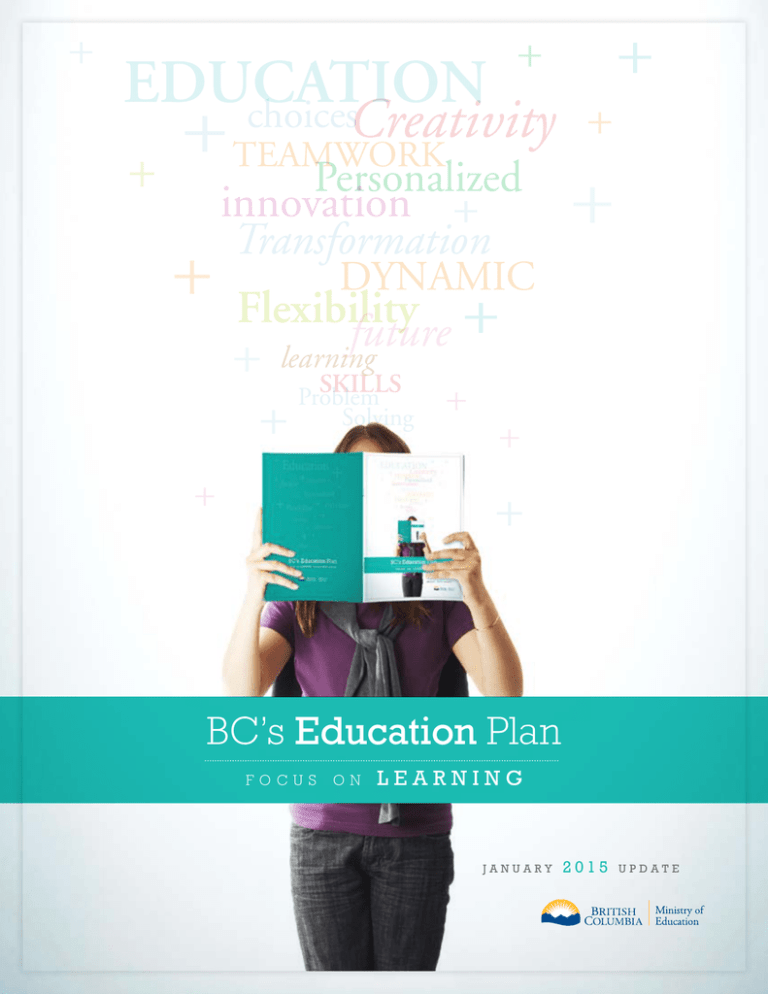
EDUCATION choices Creativity TEAMWORK Personalized innovation Transformation DYNAMIC Flexibility future learning SKILLS Problem Solving BC’s Education Plan focus on LEARNING j an u ar y 2015 update personalized Learning BC’s Education Plan Minister’s Message B ritish Columbia has one of the best education systems in the world. But it’s a world that is changing rapidly and we owe it to our students to keep pace. Three years ago, we launched BC’s Education Plan to do just that. It seeks to create a more flexible and dynamic education system where students are more engaged and better prepared for their life’s journey. The key focus is personalized learning – where students have more opportunity to pursue their passions and interests – while maintaining B.C.’s high standards on foundational skills like reading, writing and numeracy. This is not a detailed blueprint or top-down transformation. Instead, it is an affirmation of the great things that are already happening in high-performing classrooms and schools right across our province. It confirms the vision for where we are going and supports an ongoing conversation on how we can get there together. This update reflects what we’ve learned and accomplished over the past three years. It also sets new milestones and next steps. We all have a role in making sure B.C.’s young people are ready to thrive in a rapidly changing world. I look forward to working with educators, students, parents and other British Columbians to make our province’s world-class education system even better. Peter Fassbender minister of education B C E d P l a n 2 015 // f o c u s o n learning 1 2 B C E d P l a n 2 015 // f o c u s o n learning The Challenge: Education In A Changing World British Columbia has one of the best education systems in the world. Teachers are skilled, facilities are sound and students are performing at the top of international assessments. Yet it is an education system modeled on the very different circumstances of an earlier century – a time when change was much more gradual than it is today. Another major change stems from our deeper understanding of how children and adolescents actually learn. There is a large and growing body of scientific research on learning and brain development that challenges us to re-think many of our assumptions and routines. This research reinforces our knowledge that no two students learn the same way or at the same pace and that effective learning is far more than just memorizing information – it is really about getting students to apply their knowledge in real-world settings. The best outcomes are achieved through learner-centred approaches that are sensitive to individual and group differences, that promote inclusive and collaborative learning, that harness students’ passions and interests, and that deliver tailored feedback and coaching. We’ve evolved from single-room schoolhouses – where every student simply memorized what their teacher told them – to today, where information is updated continuously and a vast array of resources can be tailored to the learning needs of individual students. In a world of rapidly changing technology, students today routinely navigate through more information in a single year than their predecessors likely encountered in a decade. The economies of industrialized countries are also in the midst of dramatic change. More than ever, the economic imperative is to ensure young people entering the workforce have the lifelong skills and competencies that employers are increasingly looking for: creative thinking, problem solving, initiative, curiosity, and the ability to lead and work well in groups. SKILLS B C E d P l a n 2 015 // f o c u s o n learning 3 The Opportunity: Building On Our Strengths BC’s education system is widely seen as a global leader. International assessments consistently show that British Columbia students are, quite simply, among the best in Canada and the world. Great teachers are at the heart of this success. More than ever, we will rely on the professional expertise and discretion of teachers to guide students toward the skills and knowledge that will help them succeed – not only in the classroom but throughout their life’s journey. The diversity of our teachers, school districts and individual classrooms provides tremendous opportunities to innovate and pilot new approaches. Many of the objectives and approaches contemplated by BC’s Education Plan are already occurring in high-performing schools and classrooms. We also have a solid foundation on the monitoring of students’ progress through rigorous province-wide assessments. This is essential to student success and will be even more vital in a more personalized learning environment. Ongoing formal and informal reporting to parents on student progress will remain essential. The Vision: Young People Ready to Thrive BC’s Education Plan is based on a simple vision: Capable young people thriving in a rapidly changing world. To achieve this, we need an education system that better engages students in their own learning and that fosters the skills and competencies they will need to succeed. The focus for this transformation is the movement to increasingly personalized learning, which is enabled and supported by quality teaching and learning, flexibility and choice, and high standards. 4 B C E d P l a n 2 015 // f o c u s o n learning The Response: Personalized Learning for Every Student What is Personalized Learning? Personalized learning recognizes that no two students learn the same way or at the same pace. It also recognizes that for students to succeed in school – and to succeed after graduation – they must be engaged and invested in their learning. This means learning that is focused on the needs, strengths and aspirations of each individual young person. In a system that values personalized learning, students play an increasingly active role in designing their own education path as they develop and mature – while being held increasing accountable for their own learning success. Traditional Approach vs.Personalized Approach TRADITIONAL PERSONALIZED Possible Independent Studies Choice [Electives] STUDENT chooses from Menu of choices [ VS ] Foundation Skills [ 3Rs ] TEACHER driven Set courses K 8 STUDENT initiated,self-directed, interdisciplinary learning TEACHER Choice facilitated [Electives] co-planned with parents & teachers Foundation Skills [ 3Rs & competencies ] TEACHER managed 12 Early Years Teacher Middle Years Student Parent Teacher Student B C E d P l a n 2 015 // GraduateYears f o c u s o n learning Parent 5 From Principles to Practice 1 Principles: Learning is truly a life-long endeavour. It happens along a continuum – not in separate 2 educational programs. Intellectual development goes hand-in-hand with physical, social and emotional development. No two children will develop in all four domains at exactly the same pace, but there are generally accepted milestones along the way. Many attributes of early learning can be fostered through life – curiosity, a sense of personal well-being, thinking and reasoning, creativity and a zest for life and learning. Practice: Education evolves gradually as learners move through the continuum of human development. • Learning takes place in the home, school and community. • Learners assume increasing responsibility for themselves and others. • Foundation skills (reading, writing, oral language and numeracy) are important. • Learners develop healthy habits. • Competencies (e.g., communication, creativity, innovation, collaboration, critical thinking and problem-solving) develop over time. • Learning is assessed and reported in meaningful ways that help students improve. • The use of technology is appropriate to the age/stage and learning situation. • Learning experiences connect with students’ interest and passions. • Teaching/learning strategies are appropriate to learners’ stage of development. What Students Will Learn Personalized learning combines the “how” and “what” of learning. A personalized approach recognizes that there are still core requirements and expectations. A strong focus must remain on foundational skills – reading, writing, oral language and numeracy – and there will still be a required body of knowledge in various subjects or disciplines. However, with personalized learning there will be increased emphasis on competencies. By applying their skills and knowledge in new, often interdisciplinary situations, 6 learners will develop competencies such as: Critical thinking and problem-solving Collaboration and leadership Communication and digital literacy Personal and social responsibility Creativity and innovation Global and cultural understanding B C E d P l a n 2 015 // f o c u s o n learning flexibility CHOICE B C E d P l a n 2 015 // f o c u s o n learning 7 Quality Teaching and Learning A great teacher has always been the key to student success. More than ever, we will need to rely on the professional expertise and abilities of highly trained teachers who are able to connect with students as individuals and foster the skills, competencies, and knowledge that students will need to succeed. As children age and develop through the grades, the teacher’s role will shift increasingly towards that of a guide, coach and mentor – focusing more on helping students learn how to learn – and away from being the primary source of content and information. To ensure students are able to thrive in an increasingly digital world, BC’s Education Plan must continue to support quality learning empowered by technology. Educators will need greater access and supports to use technology that enriches the learning process, and to connect with each other, parents, and communities. Schools will increasingly rely on robust network connectivity to support learners and educators. Flexibility and Choice Students, teachers and families will benefit from more flexibility and choice with respect to how, when and where learning takes place. This means schools must have flexibility to design learning opportunities that really work for students and boards of education need the latitude to organize programs that extend beyond the typical school and classroom format. It also means a greater mix and variety of pathways to graduation and more opportunities for hands-on learning such as skills, trades and technical training. High Standards What students know and the abilities they are expected to demonstrate will continue to be reflected in a strong core curriculum, graduation standards, and rigorous province-wide assessments. This will ensure we maintain the high standards for which British Columbia is recognized internationally. As learning becomes more personalized, educators will need more flexibility to decide how and when each student is assessed. New tools and approaches are needed to provide better access, richer information, and greater consistency across the province on student progress. Reporting should move from periodic events to an ongoing conversation with parents about their child’s progress and learning objectives. 8 B C E d P l a n 2 015 // f o c u s o n learning Progress and Next Steps Significant progress has been made since BC’s Education Plan was launched in October 2011. This update includes new and emerging priorities that support the Plan’s vision as well as changes resulting from public and education sector engagement. january update october launch bc’s education plan bc’s Education Plan 2 011- 2 015 2011 2015 Provincial Curriculum Redesign New provincial curriculum is being developed to give teachers the flexibility they need to personalize their students’ learning experiences while maintaining rigorous, high-level standards. The new curriculum will increasingly emphasize key concepts, deeper knowledge, and more meaningful understanding of subject matter. It will also reflect the core competencies and skills that students need to succeed in the 21st century. Progress to date: • Working with teams of teachers, the ministry developed first drafts of re-designed K-9 curriculum for Math, Science, Social Studies, Language Arts, the Arts and Physical / Health Education, Français langue première, and Français langue seconde immersion. • First drafts of what core competencies like critical thinking, innovation and collaboration might look like as part of curriculum have also been developed. • Components of the newly designed K-9 curriculum were made available for public review and feedback starting in October 2013. Next steps: • The K-9 curriculum components are currently being revised to incorporate the feedback and will be available for exploration in schools by fall 2015. • Teacher teams will begin drafting curriculum outlines for grades 10-12 in February 2015. Once completed, the draft outlines will also be posted for public review. • The ministry is also working to ensure the K-12 curriculum addresses historical wrongs done to the Asian and South Asian communities. B C E d P l a n 2 015 // f o c u s o n learning 9 Provincial Assessment Redesign As changes are made to the provincial curriculum to better support personalized learning, it will be more important than ever for teachers, students and parents to know how students are doing. Student learning can and should be communicated to parents and students in more meaningful ways, while maintaining public confidence that B.C. students are assessed against high-level standards. Progress to date: • In 2014, the ministry engaged an Advisory Group on Provincial Assessment (AGPA) to produce a report on Elementary Years Assessment and Foundation Skills Assessments. • The ministry has analyzed the report findings, and discussed options for K-12 provincial assessments as well as definitions of provincial numeracy and literacy assessments. Next steps: • The ministry will re-engage the Advisory Group in 2015 for more details on assessment at the secondary level. • Terms of reference will be created to guide these future meetings and final AGPA report. 10 B C E d P l a n 2 015 // f o c u s o n learning Graduation Program Redesign Graduation requirements are fundamental to any changes to curriculum as they are the knowledge and competencies students must demonstrate to graduate and progress on their life’s journey, whether that is directly into the workforce, further post-secondary programs or skills training. The goal is to establish a set of graduation requirements that better reflect learning that takes place both in and outside the classroom and demonstrates the competencies, qualities and abilities that students need to succeed in the 21st century. Progress to date: • In 2012, the ministry launched public consultations in six regions with 4,000 education partners to help guide and inform proposed directions on graduation. • In January 2014, the ministries of Education and Advanced Education worked together to establish a new position of Superintendent of Graduation and Student Transitions. • The superintendent is working with the post-secondary and K-12 sector to increase the number of graduates moving from secondary school to post-secondary institutions/trades programs and careers. Next steps: • Reports from the consultations in 2012 have been reviewed and, in early 2015, a second engagement cycle will take place with educators, parents, students and major education stakeholders. • The ministry will continue to develop more flexible policies so students have greater opportunities to earn career program credits on their path to a Dogwood Diploma. • Documents detailing the vision of a new graduation program will be developed in spring 2015. Over the next two years the ministry will be working on a new vision for provincial assessment, grad requirements, and new methods to report student progress. B C E d P l a n 2 015 // f o c u s o n learning 11 B.C.’s Skills for Jobs Blueprint BC’s Skills for Jobs Blueprint calls for a more targeted focus on training for high-demand jobs, providing all partners with more up-to-date and useful labour market information, and encouraging innovation in how we provide education and training so that B.C. students and workers have the skills to be first in line for jobs. In line with the focus on personalized learning, this means providing students a head-start to hands-on learning and seamless pathways to further skills training and in-demand careers. Progress to date: • ACE-IT and Secondary School Apprenticeship enrolment increased in the 2013/14 school year, and work is underway to double apprenticeship and dual-credit training opportunities for high school students by June 2017. • A new Superintendent of Trades and Student Transitions is dedicated exclusively to expanding opportunities and building seamless pathways to training, working with districts, employers and post-secondary institutions. • Graduation program policies have been changed to provide more flexibility for skills-training courses and credits. • A Skills Exploration 10-12 course was launched to give students the opportunity to explore a variety of trades while they earn credit towards graduation. • A range of new online tools for students, parents and teachers, including a Careers Skills and Training Toolkit for school district career programs, has been launched. Next steps: • The youth apprenticeship review with the Industry Training Authority will be completed in early 2015, and approved recommendations will be implemented. • Additional supports, including strategic planning workshops, will be provided to districts to improve student access to training and apprenticeship opportunities. • Additional sampler modules for the Skills Exploration 10-12 course will be developed based on demand and labour market information. 12 B C E d P l a n 2 015 // f o c u s o n learning ERASE Bullying Expect Respect and A Safe Education (ERASE) Bullying is a 10-point comprehensive prevention and intervention strategy designed to promote positive mental health and well-being and to address bullying and other student safety matters in schools. Linked strategically with BC’s Education Plan, the ERASE strategy focuses on personalized supports and interventions for students. Launched in June 2012, the strategy provides consistent bullying prevention and threat-assessment tools, policies and protocols across all school districts, supported by the most comprehensive training program in Canada. Progress to date: • A five-year, multi-level regional training program for 15,000 educators and community partners is underway. • Currently, more than 10,000 personnel have been trained, including public, independent, and First Nations educators and community partners. • A confidential and anonymous online reporting tool for students was launched at: www.reportbullyingbc.ca • Up-to-date online resources for parents on the early warning signs and the different types of bullying – including cyber-bullying, internet slang and youth suicide – are available at www.ERASEbullying.ca • Safe school coordinators/teams and codes of conduct are in place in all 60 school districts. Next steps: • The five-year, multi-level regional training program continues with the launch of Level 3 – Advanced Threat Risk Assessment in January 2015. • Level 4 – Train the Trainer program is currently in development and will be launched in October 2015. • The ERASE Provincial Advisory Council will meet in spring 2015 to endorse Information Sharing Guidelines. B C E d P l a n 2 015 // f o c u s o n learning 13 Quality Teaching Progress to date: New Teacher Regulation System: In October 2011, the Teachers Act was passed to create a more accountable and transparent teacher regulation system. The act dissolved the BC College of Teachers and brought in a new system to certify, regulate and discipline teachers. The Teacher Regulation Branch was established in 2012, followed by the appointment of the independent Commissioner for Teacher Regulation. Teacher Mentoring Program: In April 2012, the ministry announced support for the Teacher Mentoring Project over the next three years in three pilot school districts. A partnership among UBC, the BCTF, the ministry and other education partners, the project looks to support new teachers and help them gain the confidence they need to use a wide range of instructional strategies. Next steps: • Work with universities to ensure teacher preparation programs give new teachers the knowledge and skills they require to support the movement to personalized learning. • Work with our education partners to make sure that professional development days are used to enhance educators’ knowledge base and professional expertise. It is important that teachers are able to refresh and develop new practices throughout their careers by participating in professional learning opportunities. 14 B C E d P l a n 2 015 // f o c u s o n learning Learning Supports, Strategies, and Systems New Student Information System (MyEducationBC): In November 2013, the Ministry of Education entered into a contract with Fujitsu Consulting (Canada) Inc. to deliver a new hosted student information service. Parents will be able to communicate privately with teachers and school staff while students will have an opportunity to build and manage a personal portfolio of works and submit assignments online. Teachers will be able to collaborate and share resources with colleagues as well as create secure, online learning spaces where students can coordinate on projects. Teachers will also have greater insight into the unique needs, interests and passions of students as they will have instant access to a single record for each student, covering the history of their education to date. Progress to date: • MyEducation BC is being implemented in 18 school districts and more than 50 independent schools covering 131,000 students in 2014/15. Next steps: • Plans are underway to convert the remainder of schools and districts (approximately 500,000 students) by the end of September 2015. • The previous service, BCeSIS, will be fully decommissioned by March 2016 Bill 36 – 2012 School Amendment Act: Progress to date: This amendment provided school districts more flexibility to vary the school calendar to better meet the needs of students and families and to deliver education programs through a mix of online and traditional school courses in Kindergarten through Grade 9. Learning Improvement Fund: Progress to date: In 2012, the Education Improvement Act streamlined the consultation process and introduced a new $75-million-per-year fund to better address complex classroom needs. Under collective agreements reached in 2014, annual funding will rise to more than $106 million by 2018/19. Next steps: • New processes will be available to teachers, students and parents to more quickly identify students who are struggling and to address their specific needs. B C E d P l a n 2 015 // f o c u s o n learning 15 K-12 Next Generation Network: Technology plays an important role in the classroom and in our rapidly changing digital world. The K-12 Next Generation Network initiative will help address the current and growing technology demands in the education sector. Students, teachers and school staff will have improved access to digital tools and resources that support both face-to-face and online learning. Progress to date: • In April 2014, the ministry entered into a three-year agreement with Telus to upgrade the Provincial Learning Network to a modern, high-capacity network. • To date, 206 locations have been transitioned to the new network. Next steps: • Continue implementation and work with districts to complete the project by the end of 2016/17. K-12 Accountability Framework: The ministry has a shared responsibility with school districts and stakeholders to ensure all students achieve their best. As the public K-12 system moves towards increasingly personalized learning, it is important to modernize accountabilities to ensure a stronger focus on student outcomes and to help find ways to improve the system. Under the K-12 Accountability Framework, the ministry is working with all education partners to improve district achievement contracts, superintendent’s reports and school planning councils. Progress to date: • A draft accountability framework has been developed and shared with K-12 partner groups for review and comment. Next steps: • Further province-wide feedback will be sought and incorporated this spring, and it is anticipated the new framework will be in place for September 2015. 16 B C E d P l a n 2 015 // f o c u s o n learning Innovation and Public Engagement K-12 Innovation Strategy: There is no top-down instruction manual on how to move personalized learning from concept to everyday practice. Educators on the ground will need to innovate and identify successful approaches. The K-12 Innovation Strategy will support these efforts. The heart of the strategy is the Innovation Partnership, which is the community of practice that starts to bridge the theory and practice of personalized learning. The Innovation Partnership will be composed of identified schools from around the province where educators will have greater latitude and support to try new, innovative teaching practices. A sound governance structure will be put in place to manage the supports, and identify future policy changes or directions. Each school in the partnership will be teamed with a post-secondary institution that will provide research support, capture qualitative and quantitative change, and help measure and evaluate results. The innovation partners will need to constantly communicate their activities and outcomes to help propagate successful approaches across the K-12 sector. Next steps: • Work with the representative organizations for superintendents, principals and vice-principals, and teachers to establish a governance structure in spring 2015. • Work with a governance working group to establish Innovation Partnership criteria. • Work with school districts and post-secondary institutions to begin identifying Innovation Partnership schools in April 2015. Provincial Awards Program: As we move towards more personalized learning, B.C.’s scholarships and awards will also need to reflect new forms of achievement and pathways to graduation. We will need to better align the Provincial Awards Program with the objectives of the BC Skills for Jobs Blueprint and BC’s Education Plan. Progress to date: • In 2012, the ministry consulted with education stakeholders. In September 2013, some changes were made to provide districts with greater discretion to locally manage awards and recognize more students for their unique interests. • In April 2014, BC’s Skills for Jobs Blueprint committed to increase scholarships targeted to skills training by 25 per cent. Next steps: • In February 2015, the ministry will engage in public consultations on how to improve the awards program. • It is expected any changes to the awards program could begin to be phased in for the beginning of the 2015/16 school year. B C E d P l a n 2 015 // f o c u s o n learning 17 Public Engagement: The ministry launched an ongoing “provincial conversation” about education transformation and more than 5,000 comments from British Columbians were summarized in the “What You’ve Said” engagement report. Parent Engagement: In a report entitled Toward Better Communication, parents said they want to know more than they currently do about their child’s learning experience and also want to be more directly involved in their child’s education. Next steps: • The ministry will review and update their online channels and strategies to deliver more relevant information for parents about B.C.’s K-12 system and highlight parent engagement opportunities. • The ministry will seek parent input on the Provincial Awards Program in February/March 2015 and engage parents on potential changes to student reporting/report cards in 2015/16. • The ministry will look to redesign the 2016 annual parent satisfaction survey to make it easier to complete and ensure it is aligned with the new K-12 Accountability Framework. • Depending on the progress of implementation in their respective school districts, parents will begin to access richer and more real-time information about their child’s progress through the new MyEducationBC student information system starting in the 2015/16 school year. 18 B C E d P l a n 2 015 // f o c u s o n learning Continuing the Conversation The significant progress over the past three years was achieved through the active engagement and participation of thousands of educators, students, parents and teachers. As we continue on this journey, continued engagement and co-creation will remain essential to making sure the transformations help all students reach their full potential and that they are well-prepared to thrive in a rapidly changing world. For more information and updates, visit online at bcedplan.ca or gov.bc.ca B C E d P l a n 2 015 // f o c u s o n learning 19 EDUCATION choices Creativity TEAMWORK Personalized innovation Transformation DYNAMIC Flexibility future learning SKILLS Problem Solving BC’s Education Plan focus on LEARNING BC’s Education Plan focus on LEARNING j an u ar y 2015 update
